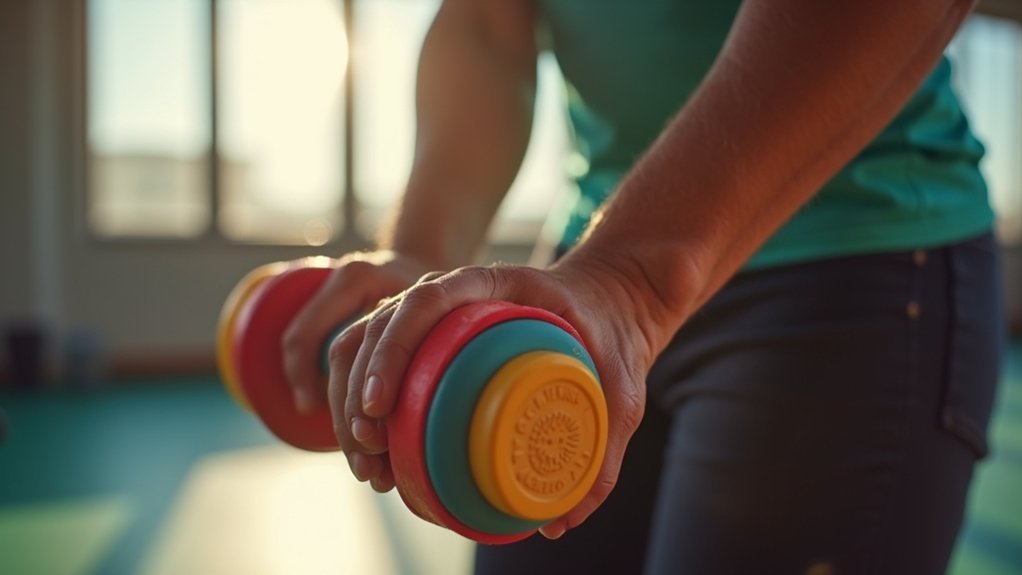Mini exercises rapidly enhance neural-muscle communication through two key mechanisms. First, your contracting muscles release myokines that promote neuron growth and responsiveness. Second, the mechanical stimulation from brief movements triggers significant neuron development—with neurons growing up to four times faster than at rest. Even short rebounding sessions on mini-trampolines strengthen these pathways, improving your coordination, balance, and proprioception. These neurological benefits explain why even quick movement breaks deliver powerful brain-body connectivity improvements.
The Science Behind Neuromuscular Activation During Mini Exercise

While many believe that effective exercise requires lengthy sessions, mini exercises actually trigger powerful neural pathways throughout your body.
These short bursts of physical activity immediately activate your central nervous system, enhancing motor neuron recruitment and maximizing muscle fiber activation.
When you perform mini exercises, your contracting muscles release myokines—biochemical signals that promote neuron growth and improve neuromuscular communication.
Research shows that even the mechanical stimulation from these brief movements can generate significant neuron development, comparable to what’s achieved through biochemical processes alone.
These quick activities boost brain-enhancing factors that foster neuroplasticity and strengthen neuronal connectivity.
This makes mini exercises particularly valuable for maintaining muscle and nerve health as you age.
Even brief movement sessions create meaningful interaction between your nervous system and muscles.
How Brief Movement Sessions Enhance Motor Neuron Firing Rates
Brief movement sessions create remarkable changes in motor neuron firing rates, a core mechanism behind the effectiveness of mini exercises. When you engage in these short bursts of physical activity, your body immediately enhances the communication between your muscles and nervous system.
- Myokines released during mini exercises stimulate neural growth and increase motor neuron responsiveness.
- Mechanical stimulation from brief movements can increase neurite growth fourfold compared to staying sedentary.
- Your neuromuscular coordination improves as motor neurons activate during these short exercise sessions.
- Neurotrophins increase with regular movement breaks, supporting motor neuron health and function.
- Even short exercise sessions notably boost the communication efficiency between your nervous system and muscles.
These physiological responses explain why you don’t need lengthy workouts to maintain neural-muscle communication—brief, consistent movement provides powerful neurological benefits.
Building Proprioceptive Awareness Through Quick Rebounding

How does your body understand its position in space without visual cues? The answer lies in proprioceptive awareness, which you can dramatically enhance through quick rebounding exercises.
When you perform dynamic movements like rebounding, you’re engaging multiple muscle groups simultaneously, improving neural communication between your muscles and central nervous system. These exercises activate mechanoreceptors in your joints and muscles, making them more sensitive to position changes.
Research shows rebounding stimulates the release of neurotrophins, supporting the growth of neurons essential for proprioception.
With consistent practice, you’ll create more efficient neural pathways, leading to better coordination, balance, and motor control.
The beauty of quick rebounding is its all-encompassing approach—training your body’s internal positioning system while reducing injury risk during more complex physical activities.
The Role of Trampoline Micromovements in Neural Pathway Development
Whether you realize it or not, those gentle bounces on a mini-trampoline trigger profound neurological changes throughout your body.
These micromovements aren’t just physical exercise—they’re neural training that enhances muscle-brain communication.
- Your trampoline activity stimulates myokine release, promoting neuron growth and strengthening neural-muscle connections.
- Mechanical stretching during bounces creates impacts that drive neural development as effectively as biochemical stimulation.
- Neurons exposed to trampoline-generated forces grow up to four times farther than non-exercised ones.
- Your central nervous system activates during dynamic trampoline movements, recruiting more motor neurons.
- These exercises can serve as therapy for nerve repair and mobility restoration in neurodegenerative conditions.
This developmental impact explains why mini-trampoline exercise yields benefits far beyond cardiovascular fitness—it’s rewiring your neural pathways with every bounce.
Myokine Release: How Mini Workouts Stimulate Nerve Growth

Every bounce on your mini-trampoline triggers a remarkable biochemical cascade within your muscles. When you perform mini workouts, your contracting muscles release myokines—powerful biochemical signals that promote nerve growth. These microscopic messengers can help neurons grow four times farther than they would without this stimulation.
| Benefit | Mechanism | Outcome |
|---|---|---|
| Nerve Growth | Myokine Release | 4x Neural Extension |
| Recovery Support | Mechanical Stretching | Enhanced Nerve Repair |
| Disease Protection | Improved Communication | Neurodegeneration Defense |
The impact of these short exercise sessions extends beyond biochemical effects. The mechanical stimulation from physical movement matches the power of myokines in promoting neural health. This dual action strengthens neural-muscle communication, potentially offering therapeutic benefits for those recovering from nerve damage or fighting neurodegenerative diseases.
Progressive Neural Adaptation Through Short Rebounding Sessions
When you incorporate short rebounding sessions into your routine, your nervous system undergoes fascinating adaptive changes over time.
These quick exercise sessions trigger dual pathways of neural enhancement:
Short rebounding exercises activate complementary neural pathways—enhancing both chemical signaling and mechanical stimulation for comprehensive nervous system support.
- Your muscles release myokines that directly promote neuron growth and communication
- The mechanical stimulation from bouncing stretches neurons in ways that enhance their functionality
- Your neural adaptability improves through consistent activation of both biochemical pathways and physical impacts
- Even a few minutes daily provides sufficient stimulus for progressive nerve health improvements
- These adaptations can support recovery from injuries and potentially slow neurodegenerative diseases
This progressive adaptation doesn’t require lengthy workouts—the dynamic nature of rebounding efficiently stimulates neural-muscle communication through mechanical forces that complement the chemical signaling of myokines, creating a thorough approach to maintaining nervous system health.
Balance Control Mechanisms Strengthened by Mini Trampoline Training
The unstable surface of a mini trampoline creates an ideal environment for your body to develop enhanced balance control mechanisms. As you bounce, your proprioception—your body’s positional awareness—is constantly challenged, strengthening neural pathways essential for stability.
Each rebound activates both your central and peripheral nervous systems, improving the communication between your brain and muscles. This enhanced neural-muscle connection results in quicker reflexes and better coordination during dynamic activities.
The repetitive bouncing motion stimulates your vestibular system, a critical component for maintaining equilibrium. You’ll experience increased muscle activation in your lower body during training, developing the strength needed to support proper balance.
Regular mini trampoline workouts effectively train your body’s balance control systems while improving reaction times for everyday stability challenges.
The Time-Efficiency Factor: Neural Benefits From Brief Bouncing
You’re triggering significant neural-muscle activation pathways when you engage in brief bouncing sessions throughout your day.
These short bursts of movement stimulate myokine release that promotes neuron growth up to four times faster than sedentary periods would allow.
The micro-movements involved in even minimal bouncing exercises maximize neuroplasticity while requiring minimal time investment, making them an efficient solution for maintaining brain-muscle communication.
Brief Bouncing Activates Pathways
Despite requiring minimal time investment, brief bouncing exercises provide remarkable neural benefits by quickly activating critical pathways between your brain and muscles.
When you bounce, you’re triggering a cascade of neurological responses that enhance your overall physical function.
- Each bounce stimulates muscle contraction, strengthening communication between your nervous system and muscular tissue.
- Your body releases myokines during these short exercise bursts, supporting neuron growth and health.
- Just 30 minutes of mechanical stimulation can greatly improve neurite length.
- The impacts from bouncing mimic effects of longer traditional exercise sessions.
- You’re activating neural pathways efficiently, making this ideal for busy schedules.
This neuro-muscle communication boost makes brief physical activity an accessible option when you can’t commit to lengthy workouts.
Micromovements Maximize Neuroplasticity
When it comes to maximizing neuroplasticity, micromovements offer an astonishing efficiency that few other exercise forms can match.
Even brief exercises trigger mechanical stimulation that promotes neuron growth comparable to biochemical myokine signaling. Your neurons can grow up to four times faster with these mini activities.
You’ll activate your central nervous system more effectively through micromovements, recruiting additional muscle fibers that enhance muscle communication pathways.
This neuroplastic adaptation happens within remarkably short timeframes—you don’t need lengthy workouts to see benefits.
The beauty lies in simplicity: short bouncing sessions or quick stretches provide sufficient mechanical stimulation to optimize performance and brain-muscle connections.
Coordination Refinement Through Rhythmic Rebounding Patterns
Your body’s coordination skills receive a powerful boost when you engage in rhythmic rebounding patterns that activate brain-body synchronization.
During mini trampoline exercises, your proprioceptive signals intensify as multiple muscle groups and neural pathways fire simultaneously.
This enhanced neural-muscle communication creates more efficient movement patterns, leading to improved balance, reaction time, and overall coordination.
Brain-Body Sync Activation
Although often overlooked, rhythmic rebounding activities serve as powerful catalysts for brain-body synchronization. When you engage in these mini exercises, your muscle and neuron communication strengthens dramatically, creating enhanced coordination pathways.
Your brain’s plasticity responds to rhythmic movements by:
- Optimizing neural pathways that control precision muscle contractions
- Increasing myokine release that supports neuron development
- Accelerating communication between your central nervous system and muscles
- Recruiting more motor units for improved performance and reaction time
- Strengthening proprioceptive feedback loops for better spatial awareness
This neurological enhancement isn’t coincidental—it’s a direct result of the repetitive rebounding patterns challenging your brain to process and respond to movement more efficiently.
You’ll experience improved athletic performance and reduced injury risk as your brain-body connection becomes more synchronized through consistent practice.
Proprioceptive Signal Enhancement
The proprioceptive feedback system undergoes significant refinement through rhythmic rebounding activities, creating neural pathways that enhance spatial awareness and movement accuracy.
When you engage in these mini exercises, your proprioceptive receptors in muscles and joints receive constant stimulation, strengthening neural-muscle communication throughout your body.
This dynamic workout approach activates motor neurons that connect directly with muscle fibers, improving your coordination with each bounce.
You’ll notice enhanced balance and agility as your body learns to respond more efficiently to changing positions.
The rhythmic rebounding patterns train your nervous system to process spatial information faster, resulting in improved athletic performance and movement precision.
Regular practice not only refines your coordination but also reduces injury risk by conditioning your body to maintain ideal positioning during physical activities.
Measuring Neuromuscular Improvements After Consistent Mini Exercise
Scientists have zeroed in on several measurable indicators that demonstrate how consistent mini exercises enhance neural-muscle communication. When you commit to regular mini exercise sessions, your body responds with remarkable neuromuscular adaptations that can be quantified through various methods.
- Increased recruitment of motor neurons leading to better muscle activation
- Elevated myokines levels that promote neuron growth and enhance nerve-muscle communication
- Higher concentrations of neurotrophins like BDNF supporting neuron survival and function
- Enhanced neurite outgrowth resulting from mechanical stimulation, even from brief activities
- Measurable gains in muscle strength and endurance reflecting improved neuromuscular pathways
These biological markers provide concrete evidence that your quick exercise bursts are creating lasting improvements in how your brain communicates with your muscles.
Frequently Asked Questions
Is Mind to Muscle Connection a Real Thing?
Yes, the mind-muscle connection is real. You’re actually improving neural pathways when you focus on specific muscles during exercise, leading to better muscle fiber recruitment and enhanced strength gains during your workouts.
How Exercise Enhances Brain Function Through Muscle Nerve Interaction?
When you exercise, your muscles release myokines that help neurons grow longer. These biochemical signals, combined with mechanical impacts from movement, strengthen neural-muscle communication and boost your brain function through this two-way interaction.
How to Develop a Mind-Muscle Connection?
To develop a mind-muscle connection, focus on feeling each contraction, perform slow reps, use ramp-up sets, minimize distractions by avoiding mirrors, and incorporate verbal cues during your exercises to enhance muscle activation.
When Muscles Work Out, They Help Neurons to Grow.?
Yes, when you exercise, your muscles release myokines that help neurons grow. Additionally, the mechanical impacts from your muscle contractions directly stimulate neural growth. This dual biochemical and physical stimulation greatly enhances neural-muscle communication.
In Summary
You’ve seen how mini exercise builds neural-muscle communication through enhanced motor neuron firing, proprioceptive awareness, and myokine release. With just minutes of rebounding each day, you’re strengthening balance control mechanisms and refining coordination. These brief trampoline sessions efficiently develop neural pathways that improve your body’s responsiveness. Don’t underestimate these micro-movements—they’re creating measurable neuromuscular improvements that benefit your everyday movements and athletic performance.





Leave a Reply